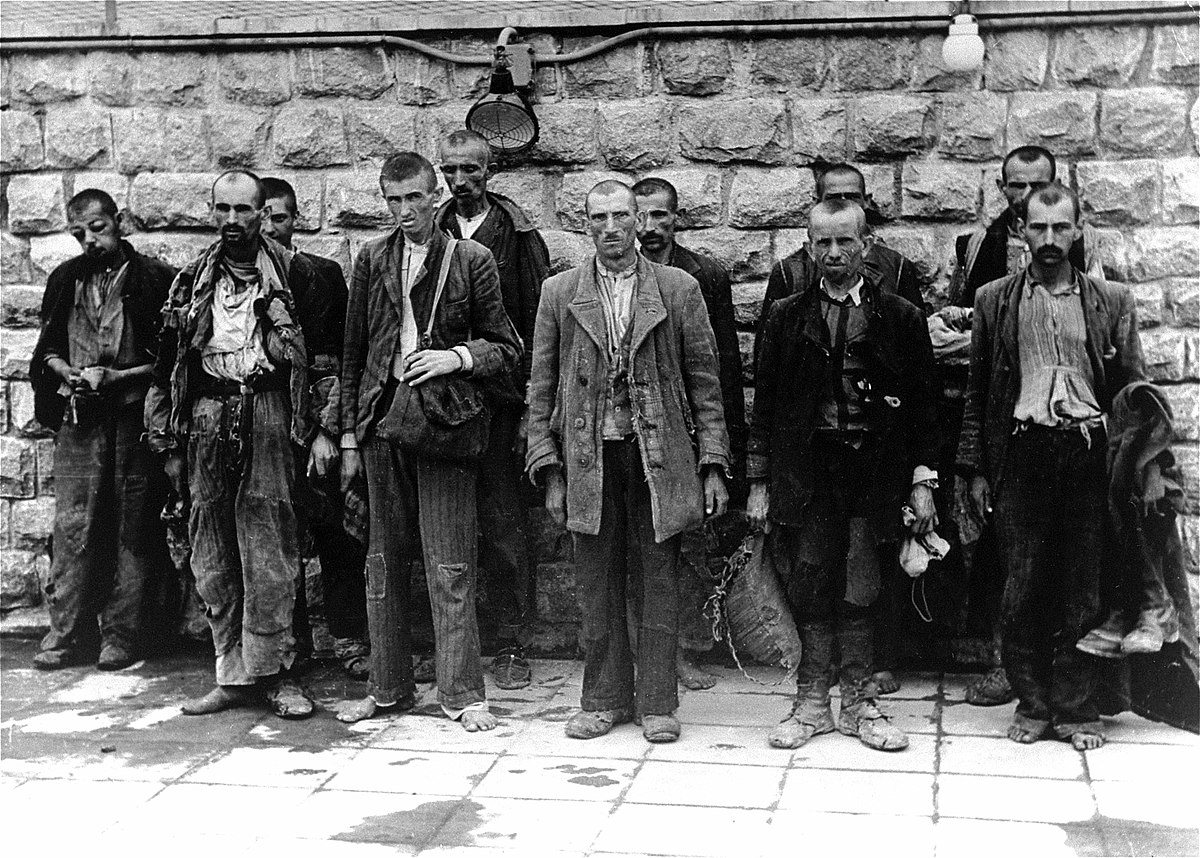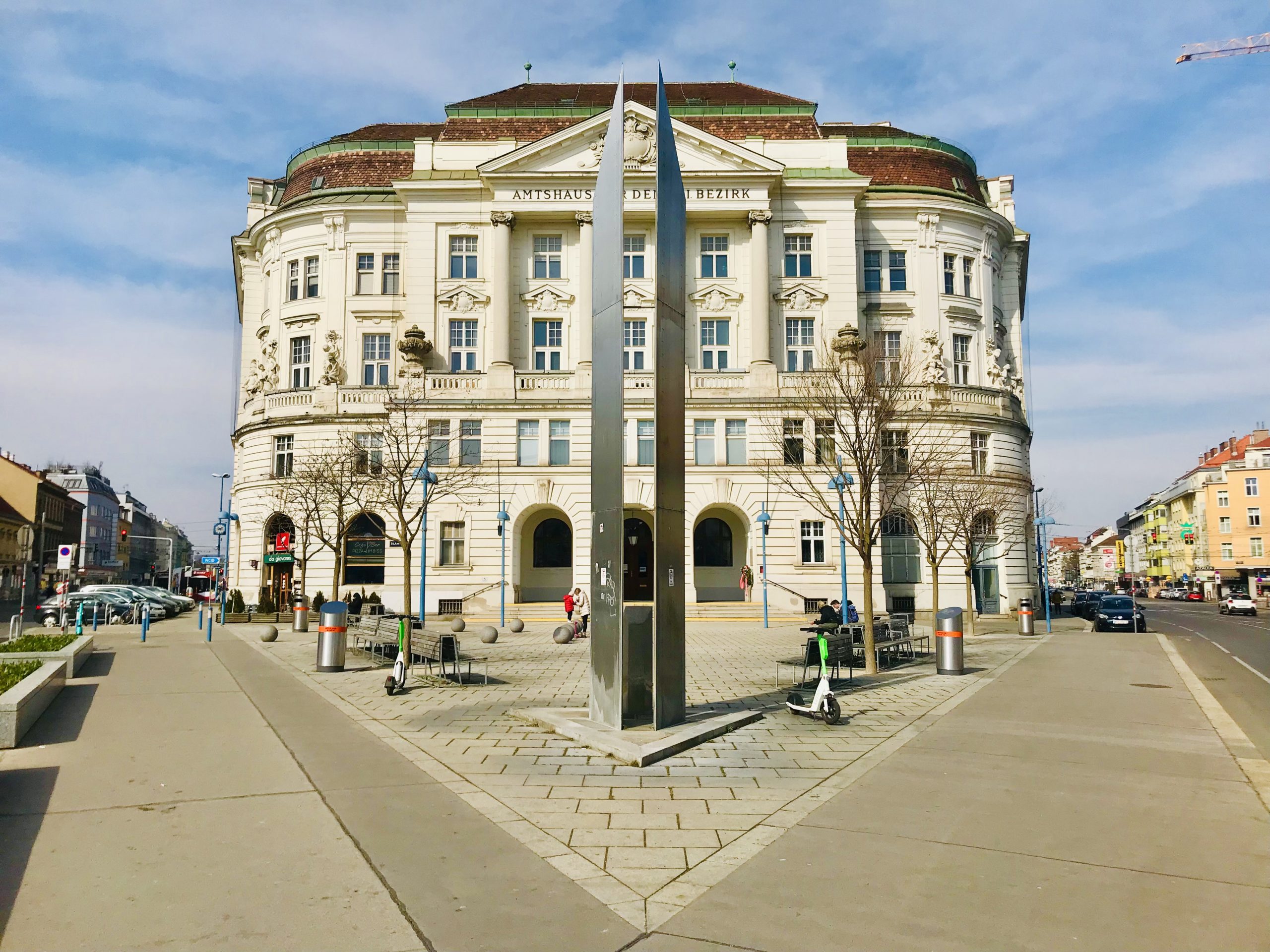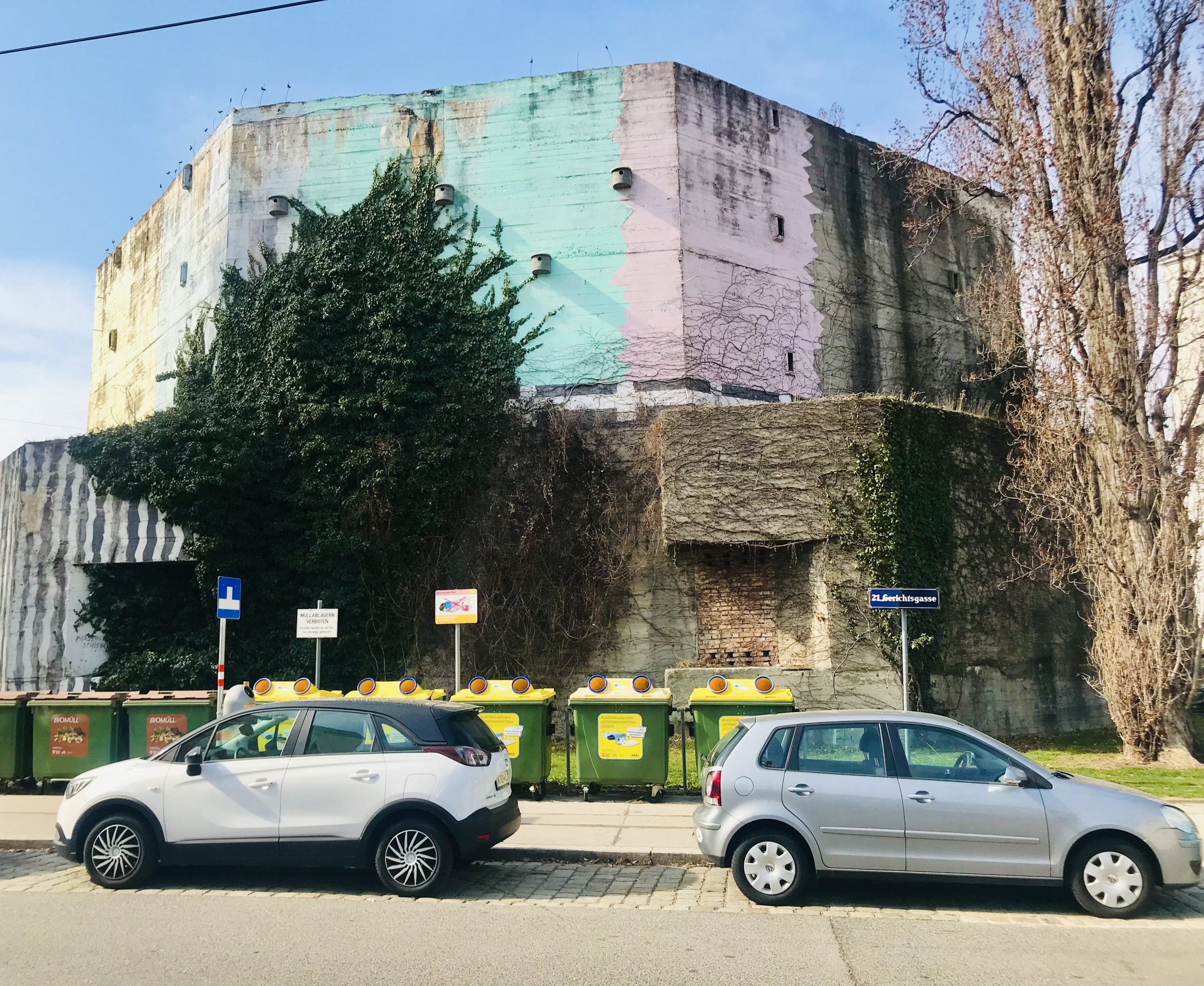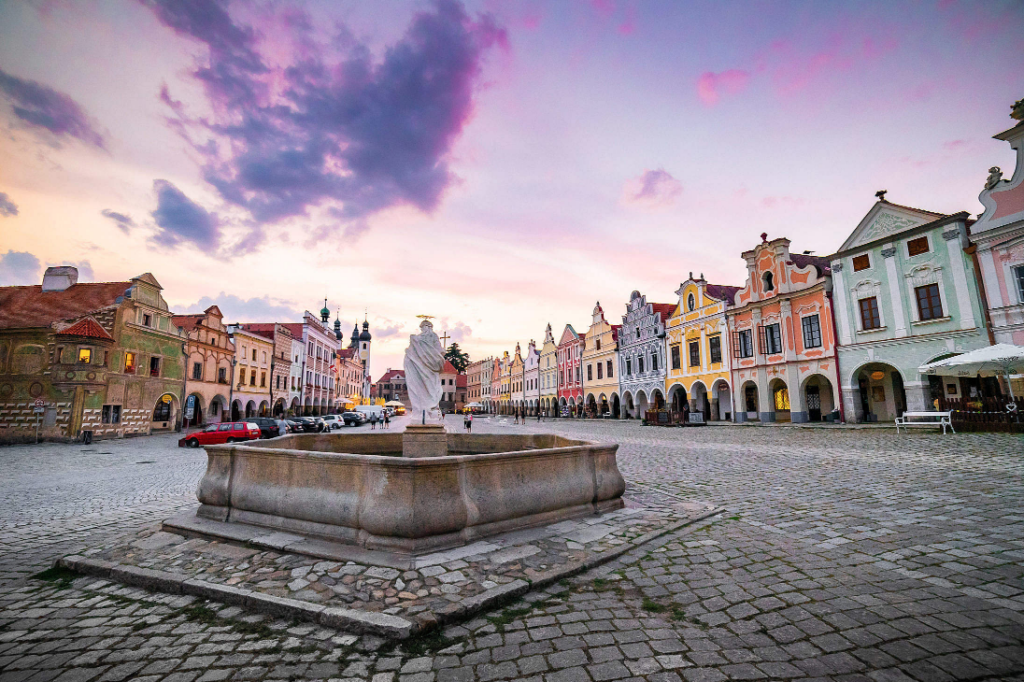
Photo by Viktor Hanacek
The Painted Ladies of Telč are among the many wondrous features of this UNESCO designated fairy tale town that really has it all.
Elegant. The only word that comes to mind to describe the medieval town of Telč, a UNESCO World Heritage Site. Telč really does it have it all — gorgeous colorful architecture, one of the most beautiful main squares in Europe, a castle surrounded by water, two clocktowers and even underground passages to explore. Renowned director Werner Herzog discovered Telč in 1979 when he used the town as the backdrop for his classic Nosferatu the Vampyre. It is no surprise that National Geographic flagged this charming gem as one of the Top 25 Travel Destinations in 2020. Would you like to discover Telč while it is still off the beaten path? Let’s go!
ZACHARIÀŠ OF HRADEC
In one of history’s great twists of irony, in 1335 the Holy Roman Emperor Charles IV exchanged Telč with Jindrich of Hradec for a border castle in Banov. (We know who got the better end of that deal.) Then in the year 1530, something wonderful happened in Telč. A massive fire consumed the majority of the wooden timber homes on the main square. Like a phoenix rising from the ashes, Telč was reborn. As Telč was rebuilt, this once forgettable town was transformed into a crown jewel of Renaissance-baroque architecture. Today, the world honors the ruler known as Duke Zachariáš of Hradec who at only 23 years of age transformed Telč with his artistic vision. Zachariáš had studied in Genoa, Italy and was inspired by the art and style of the Italian Renaissance. After he returned home, he invited several Italian architects to Telč to rebuild the town and his castle in the Renaissance style. He also set up fish farms, opened a hospital and hospice for the elderly, and turned Telč into a flourishing town. Although Zachariáš requested the Burghers adhere to some basic guidelines, he encouraged them to rebuild in whatever lavish style suited their medieval fancy. And they did.
THE TOWN SQUARE
Perched on the border between Bohemia and Moravia, Telč has been referred to as the “Czech Florence.” The reason: Telč is blessed with one of Europe’s prettiest and best-preserved historic squares (in Czech called Náměstí Zachariáše z Hradce). Designated a UNESCO World Heritage Site in 1992, the main attraction of the town square is really the square itself. Spectacular yellow, pink and green facades of Renaissance and baroque homes once belonging to affluent burghers, line the public square. The uniqueness of the homes is what makes the square so special. Each one has a different style, color, and panache. Choosing your favorite home will quickly become a topic of conversation.
Over the centuries, Telč has had its share of devastating fires. In 1386, a fire destroyed 27 Burgher homes on the square. A second fire in 1530 consumed an entire side of the square including the Town Hall. Before the 1530 fire, the original square was considerably larger than today. Along the sides of the town square, two long arcades run under the Burgher homes. Today, these never-ending tunnels of arches are home to cafes and other businesses. Unlike other popular travel destinations with high foot traffic, the square is relatively quiet and remains inhabited by people who live and work in Telč.
FUN FACT: Although today the Painted Ladies of Telč are a myriad of vibrant colorful tones, in the 1800s the entire town was painted white. Boring!
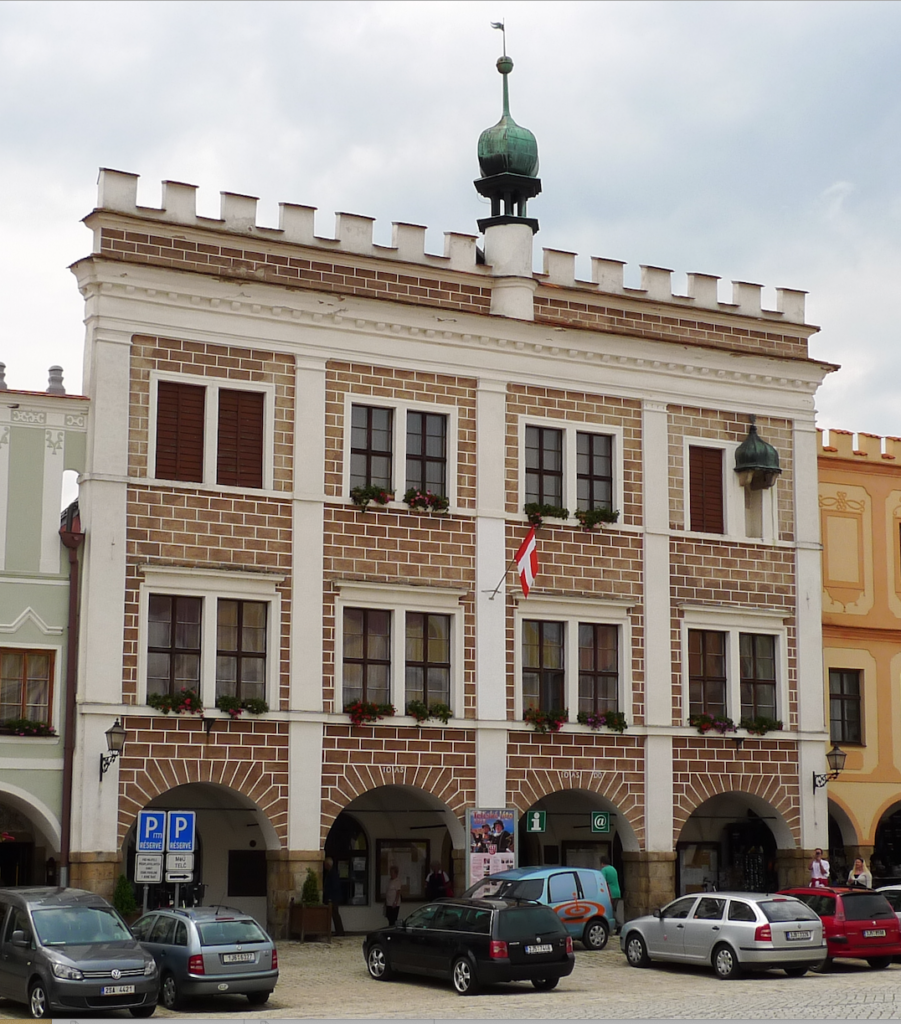
NO. 10 – TOWN HALL
In 1499, the Town Hall was completely leveled when barrels of gunpowder ignited and exploded in the cellar. During a banquet with alcohol and fireworks, a servant descended into the dark cellar with a torch that he accidentally misplaced on a barrel of gunpowder. The Town Hall was rebuilt in 1574 and occupies two original medieval plots of land on the town square. Today, the Tourist Office can be found in the Town Hall.
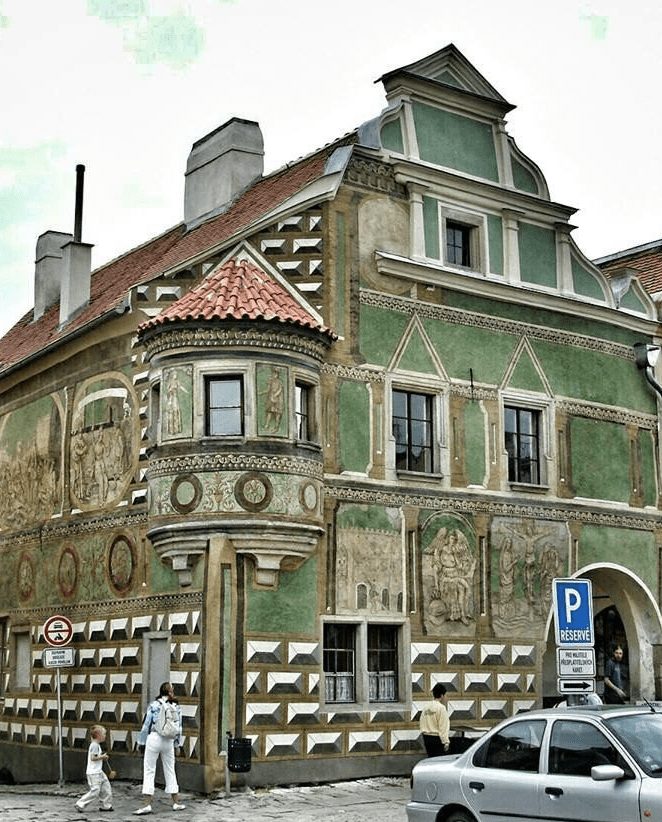
NO. 15 – THE GREEN TOWNHOUSE
The Green Townhouse with the tower is characterized by its unique sgraffito or scratch technique. In 1550, a team of Italian architects and craftsmen traveled to Telč and were commissioned to craft the new facades of the rebuilt Burgher homes. In 1952, a restoration team discovered sgraffiti underneath the white exterior paint of the homes. The Green Townhouse is known for its detailed sgraffito scenes from the Bible.
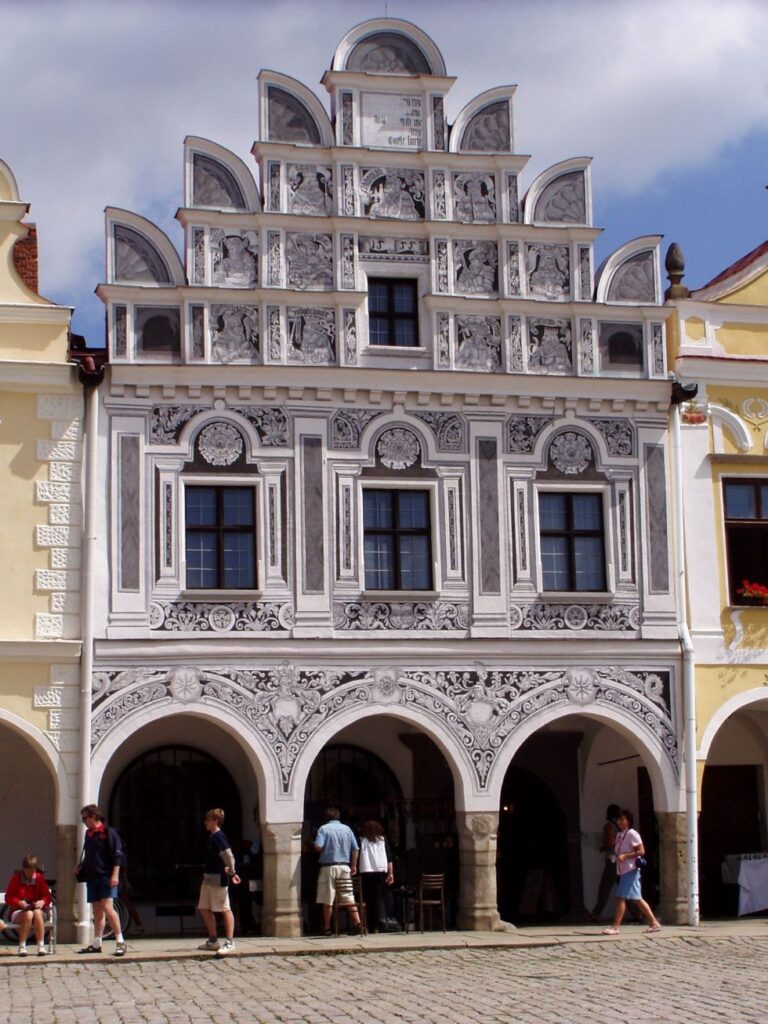
NO. 61 – THE SGRAFFITO HOUSE
In 1555, Italian craftsmen crafted battle scenes from the Old Testament on this Burgher home using the sgraffito technique. The craftsmen also carved symbols from the various trade guilds of Telč onto the columns in the arcade lining the Town Square.
GUILD SYMBOLS
Not to be missed is the medieval signage from the various tradesmen who once flourished in the market square. In the 1550s, Italian craftsmen carved these symbols into the columns of the arcade lining the square. These 500-year-old markings truly provide a direct connection to the past. Think of them as medieval billboards. For example, look for a butcher knife carved into the column that marked the location of the town’s butcher. In fact, a faded pretzel once marked the entryway of the town’s baker. We found six carved symbols. Are there more?
PLAGUE COLUMN
Typical of many towns in the region, a Plague Columns stands proudly in the upper part of the Town Square. The town erected the column in 1716 after Telč resident Zuzana Hodová donated 1000 gold pieces towards its construction. Hodová lived in Burgher house No. 52 on the square. Watch the uninformed take photographs in front of what they think is an ornate statue. Little do they know that those bulbous shapes on the statue are actually skin boils with oozing puss!

Plague columns were erected throughout the Habsburg Empire to celebrate the end of the Bubonic plague epidemic also known as the “black death.”
WATER PUMP
The observant traveler will notice the 19th-century green water pump that stands in the upper Town Square. For one hundred plus years this functioning pump has supplied fresh drinking water to the residents of Telč. Fill your water bottle.

Located on the Town Square, this functioning 19th-century water pump has continuously provided fresh water to the residents of Telč.
UNDERGROUND PASSAGES
Beneath the entire length of the town square, there is a network of underground passageways and cellars connecting all of the homes. In fact, this network pre-dates the town fire of 1386 and was used primarily for defense and safe haven from Turkish invaders, but also to store beer, wine and other goods given the consistent temperature. As electricity had not yet been discovered, these underground cellars served as the refrigerators of their day. Additionally, the passageways could provide fresh air in the event of a fire. Unfortunately, in 1530 the passageways likely sped the flow oxygen to the town fire. As a result, the intensified fire quickly consumed the Burgher homes along the square. Today, 150 meters (492 feet) of the extensive tunneling system below the main square has been opened to visitors. Guided tours lead groups through multimedia and 3D video displays. Tours are held every day on the hour from 10:00 to 3:00 p.m. Tickets can be purchased at the Information Office inside the Town Hall.

Approximately 500 feet of tunnels and cellars exist under the Town Square of Telč. This underground network pre-dates the fire of 1386. It was used primarily for defense but also to store beer, wine and other goods given the consistent temperature. If invaded, the passageways could be used to provide a safe haven. Additionally, the passageways could also provide fresh air in the event of a fire.
CITY GATES
- LOWER GATE. Before the fire of 1530, the Telč Castle was surrounded by a moat with a drawbridge. To enter the castle grounds (and lower town), one would cross the lowered drawbridge over the moat and then pass through the lower gothic gate. In 1579, the moat was replaced with a pedestrian path. Today, the gate continues to welcome and bid farewell to hundreds of thousands of people who have entered and exited this remarkable town.

To enter the castle grounds (and town), travel across the pedestrian path and pass through the lower gothic gate. Today, the gate continues to welcome and bid farewell to hundreds of thousands of people who have entered and exited this remarkable town.
- UPPER GATE. To enter the town square (and upper town), pass through the late 16th-century upper gate. This awesome two-story gate is decorated in sgraffito. In 1629, stonemasons crafted a five-petal rose in the stone at the center of the arch above the passageway. A second gate stood just beyond the upper gate; however, it was demolished in 1833. The two gates were connected by a wooden drawbridge. Today, this area has been narrowed and lined with cobblestones. Be careful when passing through as the passage is shared by both pedestrians and cars.

To enter the town square (and upper town), pass through the late 16th-century upper gate. This awesome two-story gate is decorated in sgraffito. In 1629, stonemasons crafted a five-petal rose in the stone at the center of the arch above the passageway.
CITY WALLS, FORTIFICATIONS, AND PONDS
Upon further inspection, Telč is a walled medieval city surrounded by two ponds once protected by moats and drawbridges. Just outside of the lower gate to the east of Telč is the picturesque Štěpnický pond, filled with swans and waterfowl and surrounded by a footpath. Along the medieval wall to the west of Telč is the Ulický pond. Today, the two ponds are connected by a stream in the castle park.
Simply ingenious — the entire town was enclosed by high walls with ditches constructed in front of them. If the town was threatened, water could be diverted from the surrounding ponds into the ditches. As such, the town would become an unconquerable water fortress.
The walls surrounding the city were built in the 14th century. Originally, the walls were an 9 meters (30 feet) high. In the 17th century, they were increased to an incredible 10 ½ meters (34 feet) and finished with a cornice or decorative molding. On the southeastern corner of the city along Hradební Street, the walls have been preserved at their original height.

This tower in the shallow moat are all that remain of the robust network of defense mechanisms that once protected Telč.

Since the 17th century, the city walls have been an incredible 10 ½ meters (34 feet) tall. On the southeastern corner of the city along Hradební Street, the walls have been preserved at this amazing height.
TELČ CASTLE
In 1550, Zachariáš of Hradec inherited Telč Castle (which dates from the late 1300s) from his father. Accompanied by several Czech noblemen, Zachariáš traveled to Genoa, Italy in 1551 to study Italian Renaissance architecture. Zachariáš returned to Telč influenced by Italian Renaissance. Shortly after his return, he started to transform his residence from a Gothic castle into a Renaissance palace. To achieve his aim, Zachariáš enlisted the support of several Italian architects who took up residence in Telč. The transformation of the Telč Castle was performed in two stages under the guidance of these Italian masters.
Zachariáš spent a small fortune upgrading his castle. Thanks to a bit of good market timing, Zachariáš was able to pay his bills. in 1553, Zachariáš married his first wife Kateřina of Valdštejn. Lucky for Zachariáš, he received several lucrative silver mines as part of her dowry. Today, the castle bears several coats of arms of the newlyweds. They can be found on the castle’s portals, facades and interiors. The grandest room in the castle is arguably the interior of the Golden Hall. In the early 1700s, the Slavata family acquired the town of Telč and tried to convert the town’s inhabitants to Catholicism. Later owners of the castle included the Podstatský family of Liechtenstein who built a magnificent Empire greenhouse in the castle park.
Admission to the castle is 160 CZK (USD 6.25) for Adults and 110 CZK (USD 4.25) for children/students. The castle is typically open daily from 9:00 a.m. to 4:30 p.m.

In 1550, Zachariáš of Hradec inherited Telč Castle from his father. Accompanied by several Czech noblemen, Zachariáš traveled to Genoa to study Italian Renaissance architecture. Zachariáš returned to Telč and transformed his residence from a Gothic castle into a Renaissance masterpiece.

This unusual feature of Telč Castle can be found along the footpath to the garden. The outhouse is interesting; however, the two parabolic windows are truly unique. In this vulnerable section of the castle grounds, Defenders could be alerted to the sounds of approaching invaders from two directions
TOWER OF THE HOLY SPIRIT
Telč is flanked by a clocktower in the upper town and a watchtower in the lower town. Both offer panoramic views of the town and surrounding countryside. Built in the early 13th century, the Tower of the Holy Spirit clocktower is the oldest preserved monument in Telč and sits near the Upper Gate. It originally functioned as a 49 meter (160 feet) tall guard tower. In 2017, significant repairs were carried out including the complete renovation of the roof, the historical truss, and the opening of the top floor complete with observation telescopes. An exhibit showcasing the town’s history is in the works.
Built in the early 13th century, the Tower of the Holy Spirit clocktower is the oldest preserved monument in Telč. It originally functioned as a 49 meter (160 feet) tall guard tower. The tower is located in the upper town near the Upper Gate.
TOWER OF ST. JAMES CHURCH
Originally a watch tower constructed in the early 14th century, the watchtower was rebuilt in the mid-1400s and was connected to St. James Church. Today, there are excellent views from the observation platform on the top of the tower. The Tower of St. James is located in the lower town next to Telč Castle.

Originally a watch tower constructed in the early 14th century, the watchtower was rebuilt in the mid-1400s and was connected to St. James Church. The Tower of St. James is located in the lower town next to Telč Castle.
PERSONAL FAVORITES
HOTEL TELČ. The best hotel in Telč is located on the town square in the upper town. The service is fantastic, the suite-style rooms are spacious and comfortable, and the desserts in the Cafe are to die for. The owner, Veronika, loves her guests and runs Hotel Telč in a manner every hotel should aspire to achieve. Hospitality is overly abundant here. Her homemade cakes and desserts are absolutely delectable. Hotel Telč is the perfect place for a weekend getaway or a special occasion. We highly recommend Hotel Telč and stay here whenever we are in the neighborhood. ADDRESS: Na Můstku 37, 588 56 Telč, Czechia.

HOTEL U HRABENKY. The restaurant in this historic guest house is amazing. Every item on the menu is delicious. It’s the kind of dining experience you continue to think about. The traditional ambiance is wonderful — a warm fire with adult beverages accompanied by an unforgettable savory home-cooked meal. We typically don’t write about food, but in this instance, we felt compelled. Located just a 5-minute walk from the Lower Gate. ADDRESS: Slavatovská 96, 588 56 Telč, Czechia.


IF YOU ENJOYED THIS ARTICLE… CHECK OUT OUR SELF-GUIDED WALKING TOUR:


NEARBY ATTRACTIONS
ČESKÝ KRUMLOV. A UNESCO World Heritage Site, Český Krumlov or “Little Prague” has quickly become a must-see travel destination in Central Europe.
COLD WAR: ČÍŽOV IRON CURTAIN. The last remaining section of the Iron Curtain is preserved in the small village of Čížov along the border where East once met West.

BOOKSHELF

ACCOMMODATIONS
APARTMANY CHORNITZERUV DUM. Located on the historic square of Telč, Apartmany Chornitzeruv Dum is in a 16th-century Burgher home. Luxurious, spacious, modern apartments with FREE WiFi and FREE parking. The soundproofed apartments come with hardwood floors and wooden beams, fully equipped kitchens with a dining table and a large seating area. Gothic vaulted cellar and an outdoor garden. ADDRESS: Namesti Zachariase z Hradce 56, Telč, 58856, Czech Republic.














